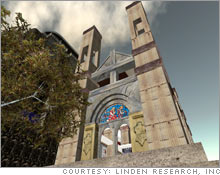How real money works in Second LifeCFO of Linden Lab talks about what it's like to operate the LindeX Currency Exchange, a real market in the virtual world.NEW YORK (CNNMoney.com) -- If you're angling to become the next business tycoon in the virtual world of Second Life, you're first going to need some Linden dollars. Linden dollars - the currency of the virtual world which can be converted into real U.S. dollars - are being pumped through the economy of the booming three-dimensional world as more people explore what it's like to live a second life.
Residents can buy and sell Linden dollars on the LindeX, Second Life's official currency exchange. CNNMoney.com asked John Zdanowski, CFO of Linden Lab - the company that created Second Life - what it's like to operate a real market in a virtual world. CNNMoney.com: Why did Linden Lab launch the LindeX Currency Exchange? John Zdanowski: The Lindex basically facilitates placing value on the Linden in-world currency. There were a lot of other players doing it out there and we thought consolidating the volume in one place would reduce volatility and improve the tradability of the Linden. Q: Is the LindeX an income generator for Second Life? A: It is, but it's a small portion - probably less than 10 percent of revenue. [Linden charges fees for currency transactions.] Q: Has the Linden dollar always been a floating currency? Why not make it a fixed rate currency? A: I think the strategy of making it floating - in letting the market set the price - makes sense to us since we have a worldwide customer base. More than half of our new users are from outside the U.S. It creates more flexibility, it's more interesting - and more fun. Q: The dollar has been sliding against a broad array of currencies the past month, how has it been holding up against the Linden dollar? A: The in-world economy has been growing so rapidly, faster than the money supply, so there's been constant pressure for the Linden to appreciate against the dollar. But we have ways to offset that. There are Linden stipends we offer to premium users. Another method we have for managing that is we can actually sell Linden directly on to the exchange. The third method we have for managing money supply is "sinks." When someone wants to do something in-world, they have to pay a Linden fee for it. For example, uploading an image or a file - residents have to pay Linden to do that. So those are the sources and "sinks" that help us manage the money supply. Q: So Linden Lab does monitor economic activity in Second Life and adjust the money supply accordingly? A: As much as we can. At this stage, we have limited tools for managing [the money supply]. We'll pull the levers we have when we can. Q: Are there any controls in place aimed at keeping the Linden dollar stable? A: There are "circuit breakers" at the broad level. There are limits on how much currency an individual can trade on a monthly and daily basis, according to how long they've been in world. There are also controls against fraud - that's something other currency exchanges don't really have to deal with. Q: How liquid is the LindeX? A: Liquidity has been quite good and it's been rapidly expanding when you net out the activity Linden does on the LindeX. There's been rapid growth as users have become more confident in the exchange itself. We can see increased confidence in terms of the Linden balances people hold - they've increased dramatically since we implemented the LindeX. Q: In the real world, demand for a currency is based on a number of factors - from interest rates to the level of economic growth. What is demand for the Linden dollar based on? A: It's based on the fact that Linden dollars represent a limited license right to use certain features of Second Life. In as much as the features people want to use in Second Life are valuable, then the Linden is valuable as a virtual currency. The other thing that makes it valuable is that people are willing to trade real currencies for it and have confidence they'll be able to do that in the future. A lot of the dynamics are like the real world. At the end of the day, growth of the use of the world and growth of the services provided in the world determine the value. Q: One of the reasons Second Life has made headlines is because residents have been prospering from virtual real estate. Do you think there may be a housing bubble in Second Life? A: I'm not sure it works that way. The world has been growing, but real estate doesn't have the same dynamic as in the real world. In the U.S. there's a fixed amount of waterfront real estate whereas in Second Life there's as much waterfront real estate as people want. There hasn't really been inflation in the value of Second Life real estate. Value is created more by what people build on it and what they do on it rather than the land itself. If someone creates something beautiful and desirable, then that can have more value for people than the base land. |
Sponsors
|

